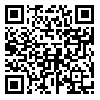Volume 45, Issue 4 (12-2021)
Research in Medicine 2021, 45(4): 89-95 |
Back to browse issues page
Download citation:
BibTeX | RIS | EndNote | Medlars | ProCite | Reference Manager | RefWorks
Send citation to:



BibTeX | RIS | EndNote | Medlars | ProCite | Reference Manager | RefWorks
Send citation to:
Khiabanirad P, Abavisani M, Eslami G, Fallah F, Hashemi A. Identification of armA, tet(39) genes, and the insertion sequence ISAba4 in clinical strains of Acinetobacter baumannii. Research in Medicine 2021; 45 (4) :89-95
URL: http://pejouhesh.sbmu.ac.ir/article-1-3011-en.html
URL: http://pejouhesh.sbmu.ac.ir/article-1-3011-en.html
Professor of Microbiology, Department of Microbiology, School of Medicine, Shahid Beheshti University of Medical Sciences, Tehran, Iran , g_eslami@yahoo.com
Abstract: (2228 Views)
Backgrond: During the past two decades, Acinetobacter baumannii has been introduced as an important clinical pathogen due to its remarkable ability to cause infections and to acquire resistance to the currently used antibiotics, including β-lactams, aminoglycosides, and tetracyclines. The aim of the present study was to determine the pattern of antimicrobial susceptibility and the prevalence of armA, tet(39) genes, and the insertion sequence ISAba4 in A.baumannii strains collected from burn patients referred to Shahid Motahari hospital in Tehran.
Materials and Methods: Totally, 92 clinical isolates of A.baumannii were collected from the burn wounds of inpatients in Motahari hospital in Tehran. The isolates of Acinetobacter were identified using laboratory and microbiological tests. Then, for the identification of species, the molecular method was carrid out by detecting the presence of the blaOXA-51 gene. The pattern of antibiotics susceptibility was performed via disk diffusion and the minimum inhibitory concentration (MIC) was performed via microdilution broth, according to CLSI guidelines. The prevalence of armA, tet(39) genes and the insertion sequence ISAba4 were investigated using PCR and Sequencing.
Results: Out of 92 A.baumannii, 95.6%, 89.2%, 97.9%, and 81.5% of the isolates were resistant to gentamicin, amikacin, imipenem, and tetracycline, respectively. All the isolates were also resistant to meropenem. The armA gene was detected in 58% of the isolates, while all strains carried tet(39) and the insertion sequence ISAba4 was detected in only 3.2% of the isolates.
Conclusion: Our study showed a relatively high distribution of armA, tet(39) genes, and the insertion sequence ISAba4 in clinical isolates of A.baumannii. This can lead to increased concerns and irreparable health costs. Drug administration, recognition of the pattern of antibiotic resistance in A.baumannii, and the study of the molecular epidemiology can be effective in counteracting antibiotic resistance.
Materials and Methods: Totally, 92 clinical isolates of A.baumannii were collected from the burn wounds of inpatients in Motahari hospital in Tehran. The isolates of Acinetobacter were identified using laboratory and microbiological tests. Then, for the identification of species, the molecular method was carrid out by detecting the presence of the blaOXA-51 gene. The pattern of antibiotics susceptibility was performed via disk diffusion and the minimum inhibitory concentration (MIC) was performed via microdilution broth, according to CLSI guidelines. The prevalence of armA, tet(39) genes and the insertion sequence ISAba4 were investigated using PCR and Sequencing.
Results: Out of 92 A.baumannii, 95.6%, 89.2%, 97.9%, and 81.5% of the isolates were resistant to gentamicin, amikacin, imipenem, and tetracycline, respectively. All the isolates were also resistant to meropenem. The armA gene was detected in 58% of the isolates, while all strains carried tet(39) and the insertion sequence ISAba4 was detected in only 3.2% of the isolates.
Conclusion: Our study showed a relatively high distribution of armA, tet(39) genes, and the insertion sequence ISAba4 in clinical isolates of A.baumannii. This can lead to increased concerns and irreparable health costs. Drug administration, recognition of the pattern of antibiotic resistance in A.baumannii, and the study of the molecular epidemiology can be effective in counteracting antibiotic resistance.
Type of Study: Original |
Subject:
Microbiology
Received: 2021/02/10 | Accepted: 2021/09/4 | Published: 2022/02/9
Received: 2021/02/10 | Accepted: 2021/09/4 | Published: 2022/02/9
Send email to the article author
| Rights and permissions | |
 |
This work is licensed under a Creative Commons Attribution-NonCommercial 4.0 International License. |







